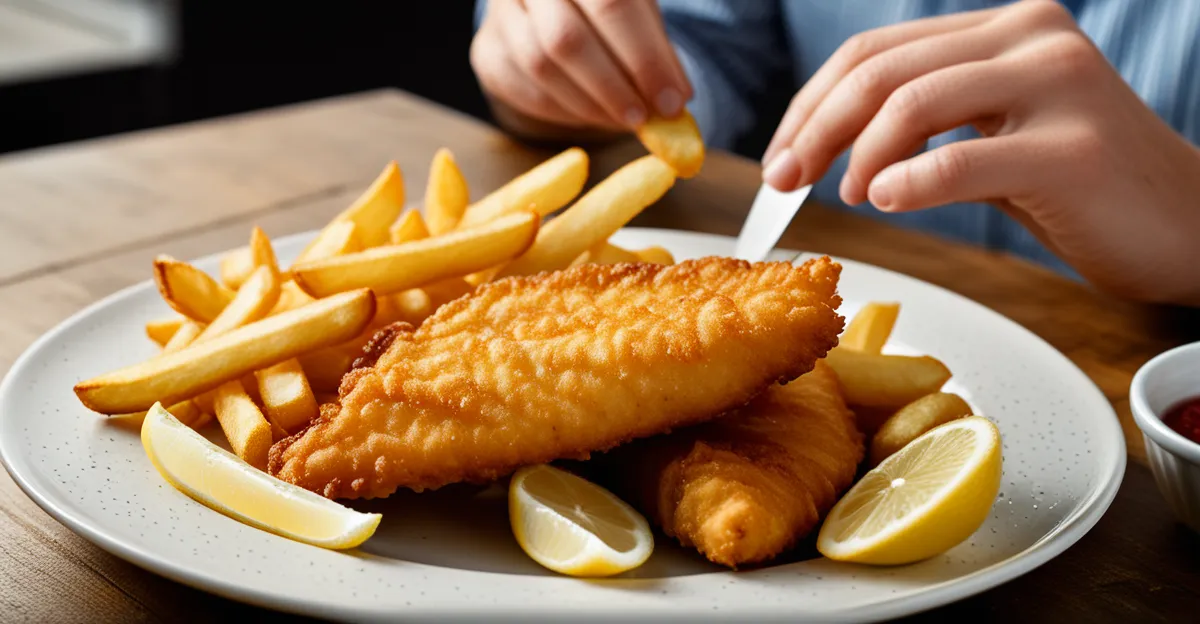Choosing the Best Ingredients for Fish and Chips
Selecting the best fish for frying is crucial to achieve the perfect balance of flavor and texture. Popular choices like cod and haddock offer a delicate, flaky consistency that holds up well during frying. These white fish varieties are prized for their mild taste and tender flesh, which contrasts beautifully with a crispy batter. When choosing fish, freshness is paramount; look for firm, moist fillets with a clean, ocean-like smell to ensure quality.
In terms of homemade chips, potato selection plays a central role in creating that desirable crisp exterior and fluffy interior. Ideal potatoes for frying are starchy varieties such as Maris Piper or Russet, which have a higher starch content and lower moisture. This combination allows the chips to crisp up perfectly without becoming soggy. Peeling before cutting and soaking the potatoes in cold water helps remove excess starch, further enhancing crispness after frying.
Emphasizing quality ingredients extends beyond just fish and potatoes. Using fresh, high-grade produce elevates the entire dish. This includes sourcing good quality cooking oil suitable for deep frying, which impacts both flavor and texture. By focusing on ingredient freshness and making thoughtful selections, you lay the groundwork for outstanding fish and chips that rival those served in top restaurants.
Mastering the Batter and Frying Technique
Crafting the perfect fish batter recipe is essential to achieving that iconic crispy fish texture. A well-balanced batter combines flour, cold sparkling water or beer, and a pinch of baking powder to create a light, airy coating. Using ice-cold liquids slows gluten formation in the flour, resulting in a crisper finish once fried. It’s crucial to mix the batter just enough to combine ingredients; overmixing can cause toughness rather than a delicate crunch.
Frying tips focus heavily on oil temperature control and cooking time. Maintaining the oil between 175°C and 190°C (350°F to 375°F) ensures the batter crisps quickly without absorbing excess oil. Using a thermometer helps keep the heat steady, preventing the fish from becoming greasy or undercooked. Fry smaller batches at a time to avoid dropping the oil temperature too much, which can result in soggy fish and homemade chips.
Achieving a crispy fish exterior while preserving moist, flaky flesh inside depends on timing as well. Usually, frying for 4 to 6 minutes per fillet is sufficient, but thickness plays a role. Thicker cuts benefit from a slightly lower temperature and longer cook time to allow heat to penetrate evenly. Also, letting fried fish rest briefly on a wire rack after cooking helps retain crispness, as placing it on paper towels can steam the batter and make it soggy.
By mastering the batter and frying technique, you transform quality ingredients into a dish with irresistible texture and flavor. This approach guarantees consistently excellent homemade fish and chips every time.
Seasoning and Flavor Enhancements
Elevating homemade fish and chips hinges on thoughtful seasoning ideas that bring depth and interest to both the fish and chips. One effective method is using marinades for fish, which infuse the flesh with subtle layers of flavor before frying. A simple marinade combining lemon juice, garlic, and herbs like dill or thyme not only tenderizes but also imparts freshness that balances the richness of fried batter.
When exploring flavor boosters, homemade seasoning blends tailored for chips can transform them from basic to memorable. A mix of smoked paprika, sea salt, black pepper, and a pinch of cayenne adds warmth and complexity. Sprinkling this blend immediately after frying ensures chips absorb the seasoning without losing crispness.
Infusing extra flavors at each stage is also crucial. For instance, seasoning the fish batter recipe with a hint of mustard powder or finely chopped fresh herbs elevates the crisp exterior with nuanced taste. Similarly, a light dusting of malt vinegar or a squeeze of fresh lemon just before serving can brighten the whole dish.
By embracing marinades, seasoning blends, and strategic flavor additions, you create a harmonious balance between crispy textures and vibrant, layered tastes—a hallmark of exceptional fish and chips.
Unique Sauces and Gourmet Sides
Creating homemade tartar sauce is a simple yet effective way to elevate your fish and chips experience. A classic tartar sauce starts with a base of mayonnaise blended with finely chopped pickles, capers, fresh parsley, and a splash of lemon juice. This combination offers a creamy, tangy contrast that complements the crisp batter and flaky fish. Adjusting ingredients like adding a dash of Dijon mustard or a pinch of cayenne pepper can customize the sauce’s flavor profile to suit personal preferences.
In addition to tartar sauce, exploring sauce recipes for fish broadens the flavor spectrum. Try a zesty aioli made from garlic, lemon, and olive oil for an herbaceous kick, or a sweet chili dip for a touch of heat. These sauces add layers of complexity and provide different taste experiences when paired with fish and homemade chips.
Beyond sauces, incorporating gourmet sides enriches the meal and adds visual appeal. Classic accompaniments such as mushy peas or coleslaw offer refreshing textures and balance the richness of fried fish. For a creative twist, consider roasting seasonal vegetables with aromatic herbs or serving a crisp, tangy cucumber salad. These sides complement the main dish while introducing freshness and color to the plate.
Together, thoughtfully prepared sauces and gourmet sides transform traditional fish and chips into a more sophisticated and satisfying feast. They invite experimentation and allow the home cook to personalize this beloved dish with flair and finesse.
Presentation and Serving Tips
Presenting fish and chips with a restaurant-style presentation transforms a simple meal into an impressive dining experience. To achieve this, start by arranging the crispy fish and golden homemade chips neatly on a plate, avoiding overcrowding which can diminish crispness. Using a white or neutral plate helps accentuate the colors and textures, making the dish visually appealing.
Garnishing plays a pivotal role in elevating presentation. Fresh lemon wedges not only add a pop of color but also offer diners a refreshing zest to brighten the flavors. A sprinkle of finely chopped parsley or chives provides a vibrant green contrast that enhances the dish’s overall look. Consider serving a small ramekin of homemade tartar sauce or other sauce recipes for fish alongside for dipping; this adds both practical and aesthetic value.
Choosing the right serving vessels at home can replicate a professional feel. Wooden boards or metal baskets lined with parchment paper evoke a classic takeaway style yet maintain elegance. Ensuring utensils and napkins are within easy reach completes the setting, encouraging diners to enjoy the meal comfortably.
Careful attention to plating fish and chips with thoughtful garnishes and well-chosen serving ware creates a memorable presentation that complements the care taken in cooking. This finishing touch invites guests to savor every bite and makes the meal feel truly special.








